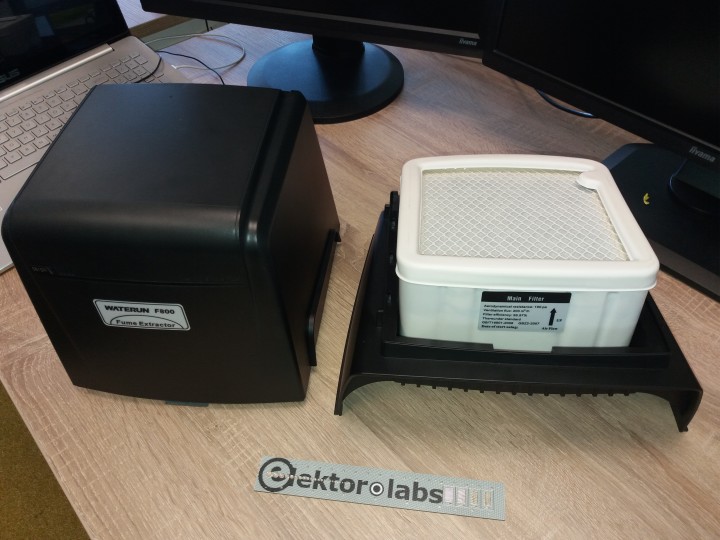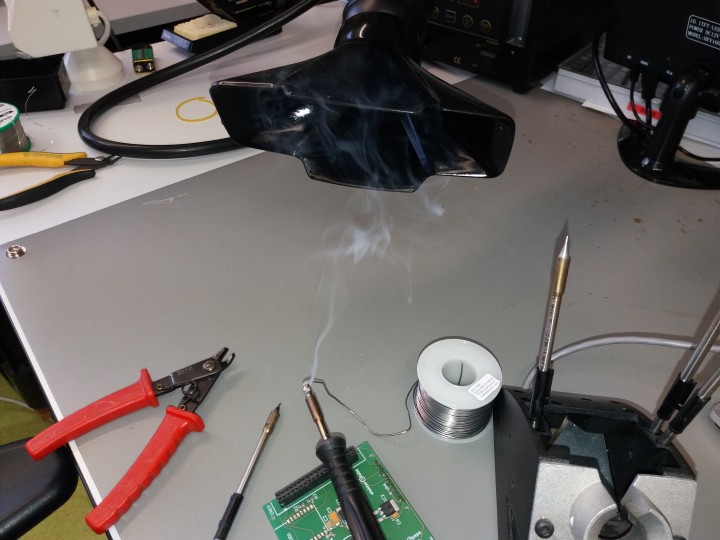Review: Waterun F800 Fume Extractor
Selection criteria
Right, you’ve been sensitised to the problem of solder fumes and seriously consider improving your work conditions with a fume extractor. As part of a question driven exercise, you could think aloud like:- How much will it cost?
- How close is to where I solder?
- How much real estate is occupied on my workbench?
- Noise! Noise!
- How effective is it?
Based on their structure and application, fume extractors with active-coal filtering for use in the home lab can be classified as follows:
- Tabletop, very close to board or work area (15 cms max.); low airflow (= power/noise) needed. Sometimes USB or battery powered. These are toy devices really.
- Tabletop, close to board or work area (30 cms max.) and level with board i.e. with horizontal suction, medium power / airflow/ noise. Useful for small work.
- Overhead, atached to a pendant or swivel, up to 1 m from work area, high power / airflow.
The Chinese-made Waterun F800 Fume Extractor on review here is in class-2 but with an extra. It is marked by these features stated by the manufacturer:
- Input: 220 V 50 Hz [sic; when will the Chinese learn about Europe’s not so recent change to 230 V?]
- Fan flow: 110 m3 / hour (metric: 367 c.ft / h)
- Filter efficiency: 99.7%
- Size: 500 (w) x 270 (d) x 300 (h)
- Base weight: 4.6 kgs
- Power: 80 W
- Noise: << 59 dB
- Anious: 5000 thousand (selective). [I wonder what that is]
Two modes
The air inlet in the base is effectively a 290 mm (w) x 45 mm (h) rectangular opening which makes the F800 look like a (black) beehive. The inlet defines two different modes of operation:- Tabletop, for quasi-horizontal fume extraction. This should work well for board distances up to 30 cms, for light work generally, and if your board is practically flush with the tabletop, like on a rubber mat. In all other cases, i.e. when the board is in a holder, on an elevated structure or if you are simply working on a large object, this mode is not satisfactory because the fumes will escape upwards. But even in tabletop mode the suction is pretty strong.

The fumes first hit a white dust filter before being pulled upwards into the base casing where the charcoal filter unit is located. Then comes the ventilator block. Cleaned air is exhausted at the back of the F800 through a coarse grille. The active-coal filter is a replaceable unit, I have no indication how long it will last or how much a replacement costs. It is easily accessible and removed.

- On table stand, with scalar trunk attached. Here comes the crux of the F800 which makes it fall in class 2.5 if you like. You put the F800 base on the table stand among your test gear i.e. approx. 50 cms above the table surface, then slide the tray coupled to the supplied “trunk” into the beehive opening, then flex the trunk so the rubber mouthpiece is where you want it (note that Waterun call the trunk a “duct”.) I really liked this mode because
- The F800 base occupies table stand space rather than tabletop space.
- It looks technically sophisticated
- The total noise from the fan and the vibration is considerably reduced due to the larger distance to my ears.
- The trunk end is easy to manoeuvre into place, and push away when not needed.

The secret to success I believe is in the detachable trunk which is about 90 cms long, 50 mm net in diameter and consists of 40 scalar elements made from hard plastic. The trunk end marked by a collar is pushed into a mating opening in the adapter tray, the other end, into the mouthpiece. The trunk is not a floppy hose but due to its 40 scales remains rigid once bent into the desired position. Happily, due to its own weight the F800 base does not budge when bending the trunk.
Read full article
Hide full article


Discussion (0 comments)